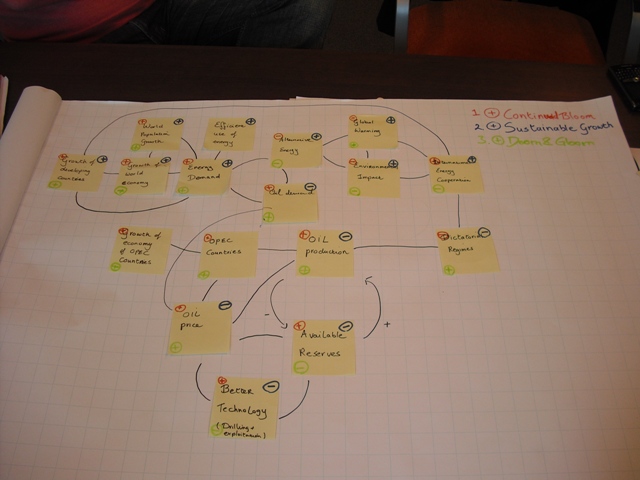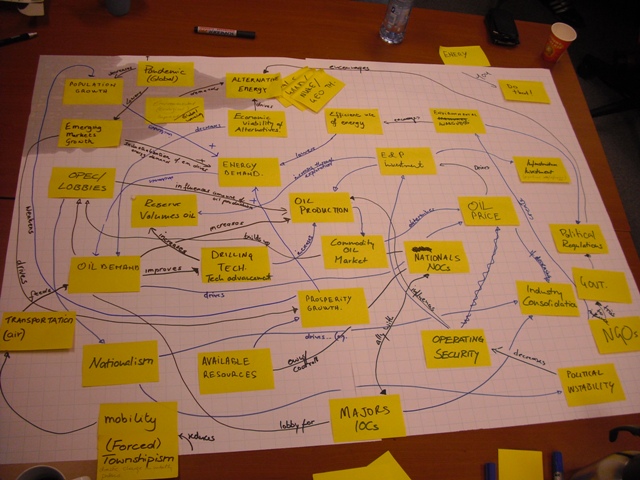Oil Production 2030
Team Members
- Mihai Andreoiu
- Michael Aouad
- Joost d'Hooghe
- Phil Poetter
- Shirley Yuen
Scenarios
Following are the 4 scenarios that have been developed for 'oil production 2030':
Under "Business as usual" the world continues its economic growth with main engines being China and India. The latter especially experiences a leapfrog towards industrialization. Western countries support the growth of emerging markets as they are huge consumer markets. World population grows to 9 bn.
Following both the increased population and the prosperity increase, especially in the Western hemisphere, the energy demand grows significantly. Energy efficiency makes progress however, it is not sufficient to compensate for the total demand. Green tech remains rather expensive and perceived as too complicated by the end user.
Substantial power resides with National Oil Companies where reserves are located, these companies engaging in bilateral deals with the emerging countries. Oil is provided not only for Dollars but also for ideological support to Venezuela, where Hugo Chavez rules the “new Cuba”. The 600 billion barrel conventional oil reserves decline steadily. However, the non-conventional oil reserves (i.e. tar sands in Canada, heavy oil on Venezuela) become more viable. Approx. 3 trillion barrels of oil seem to be available with the new extraction and production technology.
With the increased energy demand and diminished conventional oil reserves oil price rockets to USD 300 per barrel thus allowing for more spending towards non-conventional oil exploration and production. As the oil industry is very much alive and pays well more people are drawn to it so the old “crew change” phenomenon disappears.
Global warming is tackled mainly by “cap and store” solutions whereby the harmful CO2 emissions are stored underground and owned by specially created state owned enterprises.
Peak oil has not happened and global daily oil production reaches 120 mbpd.
The world characterized by the "Change of Guards" is at a turning point. Sequel to previous forums in Kyoto and Copenhagen, multi-lateral engagements at the political scene unfold and have a lasting impact. Environmental pressures is going hand in hand with an increasingly stiffening geopolitical landscape. Discussions on key issues - mainly related to global warming and its arguably strong correlation to CO2 emissions by fossil fuels - is fierce, but constructive. It becomes increasingly clear that a strong mandate and commitment is required to move forward. As a result far-reaching regulations with binding agreements are put in place, paving the way for a joint effort of the G20.
This comes at a time, where the world continues its economic growth, while population growth (at 0.8% annually) is leveling off sooner than anticipated, leading to a world population just shy of 8 billion in 2030; +17% compared to 2010 levels. Still, total global energy demand increases by twice as much in line with economic development in populous emerging markets.
Increased efforts at R&D level leads to energy efficiency gains quickly outstripping increases in global energy demand. Strong governmental support is reflected by putting in place the required infrastructure for large-scale alternative energy coverage and required production capacities.
Oil peak occurred a few years just before the turn of the decade. In 2015, ongoing discussion on reserve figures leads to a reevaluation after which OPEC countries have to adjust their figures significantly downward. From then on, oil reserves are depleting at an increasingly fast rate from a maximum of 1.3 trillion barrels and are expected to dwindle down to 100 billion barrels in 2030. While non-conventional oil resources are not economically viable to exploit, ongoing production cannot replace dwindling production rates. Globally, most wells are in their final stage of their life cycle.
With the financial competitiveness and increasing availability of alternative energy sources not only in advanced but also emerging markets, oil prices are starting a continuous decline. The much anticipated scarcity of skilled labor in the oil industry fails to appear as decreasing operating activity can be covered by the existing pool of people and productivity gains. Moreover, the Middle East and parts of Central and South America are becoming the main centers of oil production as the focus shifts towards easily accessible and cheap oil.
The oil-age is coming to an end - the age of alternative energies is in full swing.
New Driving Forces
- World population growth
- Open decentralized electricity networks
- Continental Protectionism
- Growth of developing markets
- OPEC's Role
- Remaining Oil Reserves
- Environmental Impact
- Global Warming
- Renewable sources of energy
- Coal Seam Gas
- Drilling Technology
- Increasing Efficiency in Energy Use
- Increase of International Cooperation in Energy Policy
- Proliferation of extremist / dictatorial regimes
Edited Driving Forces
Research Questions
- Will strong political and religious agendas reflect in 'oil politics'?
- Oil, as a strategic asset as well as an energy source. Will there be global political alliances between oil producing and non-producing countries?
- Has OPEC gotten its act together in order to tighten control on oil supplies?
- Will there be strong global government regulations regarding fossil fuel usage?
- How successfull have international agreements (e.g. Kyoto Protocol) been in decreasing energy use?
- How is the world economy developing?
- How is the economy in the emerging markets developing? are they going through the same industrailization process like developed countries?
- Are renewable energy sources economically viable?
- Will consumers demand green energy supply due to ongoing global warming?
- Will the growth of the population continue till 2030?
- Do oil (and gas) continue to be the major source of energy?
- Will the global energy consumption decrease due to improvements in more efficient use of energy?
- What are the chances of finding oil in not yet explored locations such as deep see regions?
- Will improvement in drilling technology increase the oil production?
- What are the alternative energy sources?
- Will changes in mobility change the use of energy?
Research Topics
- Oil Production
- Oil and Global Warming
- The Big Crew Change
- Peak Oil
- Efficiency in energy usage
- Energy Demand
- New Finds
- Geopolitics
Systems diagram
First draft systems diagram
Second draft systems diagram
Third draft using mind map
Resources
- BP - Oil reserves / Statistics 2008
- Booz&co - The Upstream Survivors 2009
- European Central Bank - Assessing the factors behind oil price changes / Working Paper Series; Jan-2008
- Global oil reserves and fossil fuel consumption
- International Energy Agency - Oil Market Report
- Renewables Global Status Report 2009 update
- Shell Scenarios
- Schlumberger
- Schlumberger - Andrew Gould at Simmons & Company International European Investor Conference
- Schlumberger - Highlighting Heavy Oil
- Simmons & Company International - Do Fossil Fuels have a sustainable future?
- Simmons & Company International - Speeches and papers
- United Nations University - different scenarios and research on global warming and the global energy outlook till 2030
- International Energy Agency - oil production in 2030 outlook

